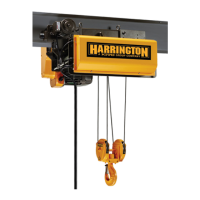43
3.13 Pre-operational Checks and Trial Operation
3.13.1 Refer to the trolley hoist’s nameplate and record the Product Code, and Serial Numbers in the
space provided on the cover of this manual.
3.13.2 Perform pre-operational checks for the trolley hoist:
Confirm the adequacy of the rated capacity for all slings, chains, wire
ropes and all other lifting attachments before use. Inspect all load suspension members for
damage prior to use and replace or repair all damaged parts.
Verify and correct all Wire Rope irregularities prior to operating the hoist.
Refer to Section 3.3.
Measure and record the “k” dimension of the Bottom Hook on the hoist. See Table 5-6 under
Section 5.
Ensure that trolley is properly installed on the beam, and stops for the trolley are correctly
positioned and securely installed on the beam.
Ensure that all nuts, bolts and split pins (cotter pins) are sufficiently fastened.
Pull down on the Pendant and ensure that the Strain Relief Cable takes the force, not the
Pendant Cord.
Check supply voltage before everyday use. If the voltage varies more
than 10% of the rated value, electrical devices may not function normally.
3.13.3 Confirm proper operation:
Before operating read and become familiar with Section 4 – Operation.
Before operating ensure that the hoist (and trolley) meets the Inspection, Testing and
Maintenance requirements of ANSI/ASME B30.16.
Before operating ensure that nothing will interfere with the full range of the hoist’s (and
trolley’s) operation.
3.13.4 Proceed with trial operation to confirm proper operation.
Verify that the controls agree with the trolley hoist direction. Make sure that depression of the
Up button lifts the Bottom Block and depression of the Down button lowers the Bottom Block.
Operate the trolley hoist through its full range of motion. Make sure the trolley hoist runs
smoothly and does not bind. Check the power supply and festoon system for proper
operation
Ensure that Wire Rope is not allowed to go “slack”.
Perform inspections per Section 5.3, “Frequent Inspections”.

